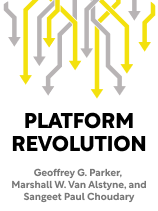

This article is an excerpt from the Shortform book guide to "Platform Revolution" by Geoffrey G. Parker, Marshall W. Van Alstyne, and Sangeet Paul Choudary. Shortform has the world's best summaries and analyses of books you should be reading.
Like this article? Sign up for a free trial here.
Do you know what your company’s purpose is? Why does your business need a purpose?
If you want to design your own platform business model, we recommend you start by defining its central purpose. This is the connection that users come to the platform for.
Keep reading to learn how to find your company’s purpose so you can design a platform.
Craft Your Platform’s Purpose
Every connection between the user and platform can be broken down into three steps: First, the platform applies a software tool to create appropriate connections between producer and consumer (for example, a search tool that ensures someone looking for a dog sitter isn’t connected with a cat sitter.) Once the connection is made, the consumer can see what the producer has to offer. Finally, based on that information, the producer and consumer can choose whether to proceed further with a transaction. Usually, but not always, the transaction involves the consumer paying money for the producer’s offerings.
(Shortform note: In The $100 Startup, entrepreneur Chris Guillebeau offers some tips that can help you define your platform’s central purpose: Start by determining your target audience—in this case, both producers and consumers—and their demographics (including their interests and values). You can use their demographic information to come up with the ideal product to meet their needs. For example, if your target audience is young people interested in sustainable living, you might plan for your platform to connect them with eco-friendly producers. Once you have some ideas for your platform’s central purpose, evaluate them based on criteria like effort and profitability; this can help you narrow down your options to a single focus.)
Parker, Van Alstyne, and Choudary stress the importance of highlighting your company’s purpose and sidelining additional features when you design your platform’s software. They explain that as your platform grows, users’ needs may evolve, and your platform should develop additional features to meet those needs. However, you should use software tools to make your central purpose visually dominant and easy to find (for example, by putting it on users’ homepages) while making additional features accessible through a navigation menu. This ensures that your central purpose doesn’t get lost or overshadowed and clarifies the value your platform offers to users.
To illustrate, consider the design of X. When you open the app, you see tweets from people you follow and recommended tweets—this makes sense since the platform’s central purpose is to connect users via tweets. If you want to take advantage of other features, like X spaces, you can navigate to them using the menu. This design allows users to access additional features without adding distracting clutter to the main feed.
(Shortform note: In Dotcom Secrets, Russell Brunson characterizes this strategy as a sales funnel, or a standardized website layout that puts the product you’re selling front and center and easily guides customers through each step of making a purchase. Sales funnels are key to building a successful e-commerce website because they streamline the buying process, which translates into an optimized user experience and increased sales. Although Brunson is primarily writing about pipeline e-commerce businesses whose central purpose is to sell products, the sales funnel concept can easily be adapted for all types of platforms with various core purposes: For example, X uses the concept to streamline its central purpose (connection via tweets).)

———End of Preview———
Like what you just read? Read the rest of the world's best book summary and analysis of Geoffrey G. Parker, Marshall W. Van Alstyne, and Sangeet Paul Choudary's "Platform Revolution" at Shortform.
Here's what you'll find in our full Platform Revolution summary:
- How platforms like Spotify and Amazon became so successful
- What makes platform businesses so unique and competitive
- Tips for aspiring platform entrepreneurs






